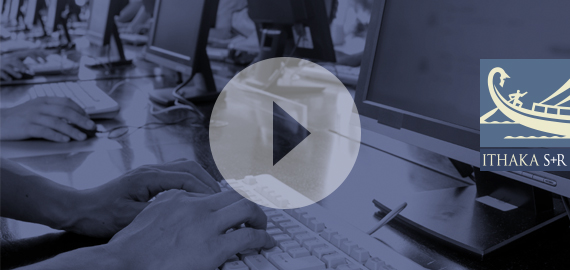Interactive Online Learning on Campus
Testing MOOCs and Other Platforms in Hybrid Formats in the University System of Maryland
Online technologies show promise for educating more people in innovative ways that can lower costs for universities and colleges, but how can higher education leaders move forward, confident in their choices about how best to integrate these technologies on their campuses? With a grant from the Bill & Melinda Gates Foundation, Ithaka S+R is working to help provide the answer.
Since November 2012, Ithaka S+R has been working with the University System of Maryland (USM) to test a variety of online learning technologies, assess student learning outcomes, and document lessons learned from these implementations. The USM is serving as a test bed for employing MOOCs from Coursera, the Open Learning Initiative (OLI) from Carnegie Mellon, and Pearson in a variety of subject areas on different campuses.
Watch our series of six video interviews with USM faculty on Vimeo.
While the tests with Pearson are continuing, Ithaka S+R has now published Interactive Online Learning on Campus: Testing MOOCs and Other Platforms in Hybrid Courses in the University System of Maryland. Looking specifically at how faculty in the USM incorporated MOOCs and OLI into their courses, our report points to several positive outcomes:
1) Using MOOC and OLI courses in hybrid formats, faculty were able to achieve outcomes comparable to traditionally taught sections with, on average, considerably reduced class time
2) Students in these hybrid sections fared as well or (using OLI) slightly better than students in traditional sections in terms of pass rates, scores on common assessments, and grades;
3) These findings held true for academically at risk students as well, including those from low-income families, under-represented minorities, first-generation college students, and those with weaker academic preparation.
Through our research we also gained a better understating of the specific barriers that need to be addressed before a wider-scale adoption is possible. Many of these stem from the fact that most MOOCs were not initially designed to be used on campus, so it took extra effort to make technology systems, intellectual property rights, and the online content work in a campus environment.
The challenges we documented are not insurmountable. But to further accelerate the use of MOOCs and OLI—and to test their potential for cost savings—an incremental approach is insufficient. Their adoption would need to be part of a concerted institutional strategy that includes the necessary incentives, rewards, and support structures for their faculty.
*An interim report was published in October 2013, and an issue brief entitled MOOCs in the Classroom? is also available.
AttributionNonCommercial 4.0 International License License. To view a copy of the license, please see http://creativecommons.org/licenses/by-nc/4.0/. ITHAKA is interested in disseminating this report as widely as possible.
